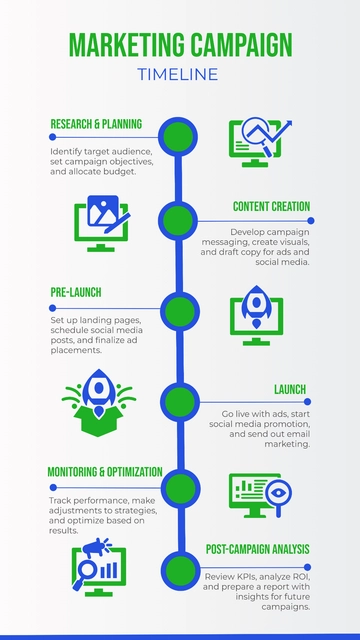Free Marketing Advertising Protocol

Introduction
A. Overview
This document outlines the standardized protocol for marketing advertising activities at [Your Company Name]. It aims to provide a comprehensive guide for team members involved in advertising campaigns, ensuring alignment with the company's objectives and compliance with relevant regulations.
B. Scope
This protocol applies to all advertising activities, both online and offline, undertaken by [Your Company Name]. It covers the planning, execution, and monitoring stages of advertising campaigns.
C. Purpose
The purpose of this protocol is to establish a standardized approach to advertising, ensuring that all campaigns are effective, compliant, and aligned with the company's strategic goals.
Objectives
A. Primary Objectives
The primary objectives of our advertising activities include brand awareness, customer acquisition, and revenue growth.
B. Secondary Objectives
Secondary objectives may include customer retention, engagement, and community building.
C. Metrics for Objectives
The success of these objectives will be measured using Key Performance Indicators (KPIs) such as Click-Through Rate (CTR), Conversion Rate, and Return on Advertising Spend (ROAS).
Target Audience
A. Demographics
The following table outlines the demographic characteristics of our target audience:
Age Group | Gender | Location | Income Level |
18-24 | Male | USA | Middle |
25-34 | Female | USA | High |
To visualize the demographic distribution of our target audience, the following pie chart is provided:
Psychographics
Our target audience values quality, convenience, and innovation. They are likely to be tech-savvy individuals who appreciate well-designed products and services.
Audience Segmentation
Audience segmentation will be conducted based on demographics, psychographics, and behavioral patterns to create more targeted campaigns. Segmentation will be done using tools like Google Analytics and Facebook Audience Insights.
Audience Research
Periodic research will be conducted to update our understanding of the target audience. This may include surveys, focus groups, and social media analysis.
Advertising Channels
A. Online Channels
Social Media: Platforms like Facebook, Instagram, and Twitter will be used for brand awareness and customer engagement.
Search Engines: Google Ads will be used for targeted advertising based on search queries.
Email Marketing: Newsletters and promotional emails will be sent to existing customers and leads.
B. Offline Channels
Print Media: Newspapers and magazines will be used for brand visibility.
Television: TV ads will be used for mass reach.
Radio: Radio spots will be used for local advertising.
C. Channel Selection Criteria
Channels will be selected based on their reach, cost-effectiveness, and alignment with the target audience. A SWOT analysis will be conducted for each channel to assess its suitability.
D. Channel Integration
A multi-channel approach will be used to ensure a cohesive and integrated advertising strategy across all platforms.
Budget Allocation
A. Budget Breakdown
The budget will be broken down into fixed and variable costs, including creative development, media buying, and analytics.
Cost Type | Percentage of Budget |
Creative | 20% |
Media Buying | 60% |
Analytics | 10% |
Miscellaneous | 10% |
B. Advertising Channels
To visualize the budget allocation across various advertising channels, the following pie chart is provided.
C. Budget Approval Process
All budgets must be approved by the Marketing Director and Finance Department before campaign initiation. A formal proposal must be submitted and reviewed before approval.
D. Budget Monitoring
Budget utilization will be closely monitored to ensure optimal allocation of resources. Any deviations will be reported and adjusted accordingly.
Compliance and Regulations
A. Legal Requirements
All advertising activities must comply with federal and state laws, including but not limited to the Federal Trade Commission (FTC) guidelines.
B. Company Policies
All campaigns must align with [Your Company Name]'s ethical standards and brand guidelines. This includes the use of approved logos, color schemes, and messaging.
C. Compliance Monitoring
Regular audits will be conducted to ensure all advertising activities are in compliance with legal and company policies. Non-compliance will result in corrective actions.
D. Compliance Training
All team members involved in advertising activities will undergo compliance training to ensure understanding and adherence to all regulations and policies.
Monitoring and Reporting
A. KPIs
Key Performance Indicators (KPIs) will be used to measure the effectiveness of advertising campaigns. These include:
Click-Through Rate (CTR): Measures the percentage of clicks received per impressions.
Conversion Rate: Measures the percentage of completed goals per visitor.
Return on Advertising Spend (ROAS): Measures the revenue generated per dollar spent on advertising.
B. Reporting Schedule
Monthly reports will be generated and reviewed to assess the performance of advertising campaigns. These reports will be shared with all stakeholders for review and action.
C. Reporting Tools
Tools such as Google Analytics and Adobe Analytics will be used for data collection and analysis. Custom dashboards will be created to monitor KPIs in real-time.
D. Reporting Responsibilities
The Marketing Analytics team will be responsible for generating and distributing reports. Any anomalies or areas of concern will be escalated to the Marketing Director for immediate action.
Crisis Management
A. Crisis Identification
A crisis in the context of advertising could range from a poorly received campaign to legal issues. Early identification is crucial for effective management.
B. Crisis Response Team
A dedicated team will be assembled to handle crises, consisting of members from the Marketing, Legal, and Public Relations departments.
C. Crisis Communication Plan
A communication plan will be established, outlining the channels and methods for internal and external communications during a crisis.
D. Post-Crisis Analysis
After the resolution of the crisis, an analysis will be conducted to understand its origins, how it was managed, and ways to prevent similar incidents in the future.
Vendor Management
A. Vendor Selection
Vendors for advertising services will be selected based on their expertise, reliability, and alignment with [Your Company Name]'s values.
B. Vendor Contracts
All vendor contracts must be reviewed by the Legal department to ensure they meet compliance standards and protect the interests of [Your Company Name].
C. Vendor Performance Evaluation
Vendors will be periodically evaluated based on the quality of service, adherence to deadlines, and overall contribution to advertising objectives.
D. Vendor Relationship Management
A Vendor Relationship Manager will be assigned to manage all interactions with the vendor, including contract negotiations, performance reviews, and conflict resolution.
Employee Training and Development
A. Training Programs
All employees involved in advertising activities will undergo training programs to enhance their skills and understanding of company protocols.
B. Skill Assessment
Periodic assessments will be conducted to gauge the skill levels of employees and identify areas for improvement.
C. Professional Development
Opportunities for professional development, such as workshops and certifications, will be provided to employees to keep them updated with the latest industry trends and best practices.
D. Employee Recognition
Outstanding performance in advertising campaigns will be recognized and rewarded to motivate employees and set a benchmark for excellence.
Appendices
A. Appendix A: Glossary of Terms
A list of terms and acronyms used in this document, along with their definitions, to ensure a common understanding among all stakeholders.
CTR: Click-Through Rate
ROAS: Return on Advertising Spend
KPI: Key Performance Indicator
B. Appendix B: Sample Advertising Campaign Plan
A sample advertising campaign plan is attached to provide a practical example of how to implement the protocols outlined in this document.
C. Appendix C: Compliance Checklists
Checklists to ensure that all compliance measures are being followed during the planning, execution, and monitoring stages of advertising campaigns.
D. Appendix D: Contact Information
A list of key contacts within [Your Company Name] and external vendors, including their roles and contact details.
Marketing Director: [Contact Details]
Legal Advisor: [Contact Details]
Vendor Relationship Manager: [Contact Details]
Revision History
Version | Date | Changes Made | Author |
1.0 | 09/28/2050 | Initial Release | [Your Name] |
For further information, please contact [Your Email] or visit [Your Company Website].
- 100% Customizable, free editor
- Access 1 Million+ Templates, photo’s & graphics
- Download or share as a template
- Click and replace photos, graphics, text, backgrounds
- Resize, crop, AI write & more
- Access advanced editor
Ensure compliance and consistency in your advertising efforts with our Marketing Advertising Protocol Template. This document provides guidelines and procedures for creating and reviewing marketing and advertising materials to ensure they align with your organization's branding and legal requirements. It's an essential resource for marketing professionals looking to maintain brand integrity and regulatory compliance. Secure your copy today and establish clear protocols for your advertising processes.
You may also like
- Marketing Google Slide
- Marketing Letter
- Marketing Quotation
- Marketing Report
- Marketing Strategic Plan
- Marketing Plan
- Marketing Proposal
- Marketing Flyer
- Marketing Presentation
- Real Estate Marketing Plan
- Marketing Contract
- Marketing Agreement
- Marketing Resume
- Marketing Checklist
- Marketing Brochure
- Marketing Banner
- Marketing Schedule
- Marketing Vector
- Marketing Logo
- Marketing Chart
- Marketing Campaign Plan
- Marketing Budget
- Marketing Postcard
- Marketing Poster
- Marketing Facebook Post
- Marketing Instagram Post
- Marketing Newsletter
- Marketing Infographic





























